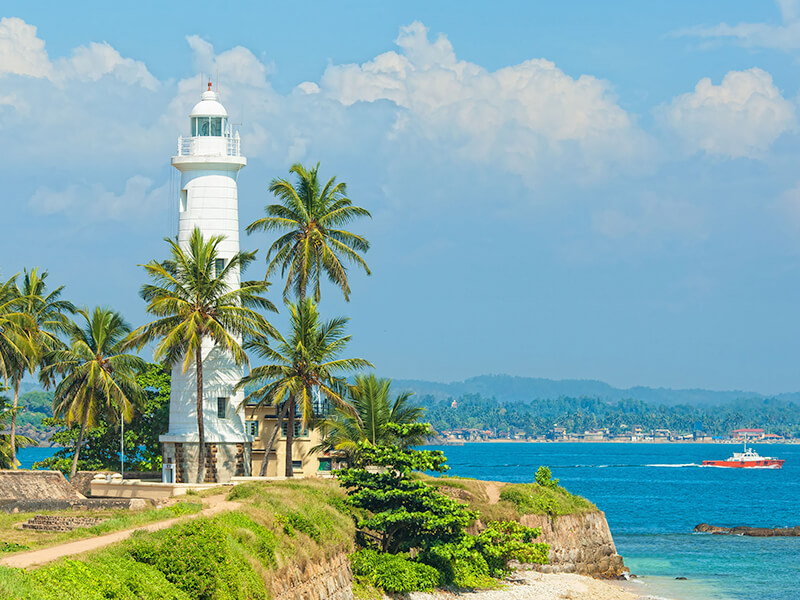Are you looking to do a trip around the country after your Ayurveda treatment in Sri Lanka? Or are you planning ahead for your Galle Fort excursion with Surya Lanka? As the most prominent city in the south of the country, a UNESCO site and the epicentre of Art in Sri Lanka, a visit to the Galle Fort should be on everyone’s bucket list when visiting our beautiful country.

Three European powers have left their imprint on Sri Lanka throughout its history – the Portuguese from around 1505, the Dutch from around 1658 and the English from around 1796. It was the Portuguese who first discovered Galle, whose harbour was where the first Portuguese ships landed in Sri Lanka. It was also the Portuguese who first built the Galle Fort (in a basic form) and the Franciscan Church within it, which can still be seen today. They named the fort ‘Santa Cruz’.
However it was the Dutch who were instrumental in building the Fort in its present form – which is quite evident in its architectural style. This included the erection of Warehouses for trade, buildings for public administration such as Courts, as well as a Protestant Church in Baroque style. Fortifications were added for defence. The impact the Dutch had on Galle and its Fort is evident in it still being commonly referred to as ‘The Dutch Fort’.
Under the British Galle declined in prominence, as Colombo (the present capital) was preferred as the main port and administrative centre. However in recent times the Fort has flourished as the centre of art in Sri Lanka, being home to many artists, poets, songwriters and the like. Rapid gentrification has led to a burst of Boutique hotels, eateries and cafes, restoring the old Dutch buildings to its former glory.

Visit the old Lighthouse – if you have chanced upon a picture of the Galle Fort, it is very likely that it included this Lighthouse. Framed by coconut trees and postcard-perfect, it is the most recognisable feature of the Fort. The structure dates back to 1848 (rebuilt in 1939) and stands on the ramparts facing the sea. Sunset is the best time to visit, when the sun sinks in the background.
Take a walk around the outer walls facing the sea – The ‘Fort Walk’ is a 2km walk along the ramparts starting at the old Clock Tower, past the Main Gate, Dutch Reform Church and the restored Dutch Hospital. From there, you can continue towards the Lighthouse, Meeran Mosque, and Triton Bastion, with the final stop being the Star Bastion overlooking the Northern coast. This walk is best attempted early in the day or late in the afternoon, when the temperature is milder. I would recommend late afternoon so that you can catch the sunset.
Take a walk through the Fort’s interior – Nowhere in Sri Lanka is the concept of a ‘melting pot’ more evident than in the Galle Fort. Centuries old buildings house shiny new boutique stores. Glitzy hotels and crumbling old houses stand side by side. Vintage cars can be spotted alongside ‘tuk tuks’. The tropical sun beats down on cobblestone streets akin to those found in medieval Europe. Walking through the alleyways you can get a feel for Sri Lanka’s past and present.
Visit the Dutch Reformed Church – If you have some extra time you can visit this Church, originally known as Groote Kerk. Highlights include the imposing pulpit and Organ as well as the Gravestones from Dutch cemeteries.
Shopping – The Galle Fort houses many of Sri Lanka’s trendiest boutiques, specially in and around Pedlars Street. If you are intent on taking home a souvenir this is the place to get it from. Notable shops include Barefoot, Exotic Roots, KK Collection, TPV and Stick No Bills.

Church Street Social – Featuring elements of Moroccan, Turkish and Middle Eastern cuisine to match the building’s Arabic influences, this upbeat restaurant is a great choice for a casual lunch or dinner.
Aqua Forte – A fairly new addition to the Fort’s impressive list of restaurants, Aqua Forte is the place to go for an elegant italian dinner.
Amangalla – A touch of old world charm. One of the Fort’s historic buildings has been remodelled into a stunning boutique hotel. I would recommend visiting for the Afternoon High Tea in the Zaal (Dining Room).
Isle of Gelato – If the heat catches up with you – and you are not on the excursion of course! – an Ice Cream might offer some respite. The Pistachio is a must try!

Fort Bazaar – The Boutique Hotel in which the aforementioned ‘Church Street Social’ is housed in, this restored merchant’s home offers a contemporary touch to the otherwise old world feel of the Fort.
Taru Villas (Rampart Street) – One of the few properties within the Fort to offer the luxury of a swimming pool, this beautifully restored villa is a great choice for a luxurious stay within the walls of the Fort.
Tamarind Hill – Around 10 minutes away from the Fort, Tamarind Hill is perfect for guests who do not want to stay within the hustle and bustle of the Fort itself. It features a beautiful colonial building wrapped around a central courtyard/lawn.